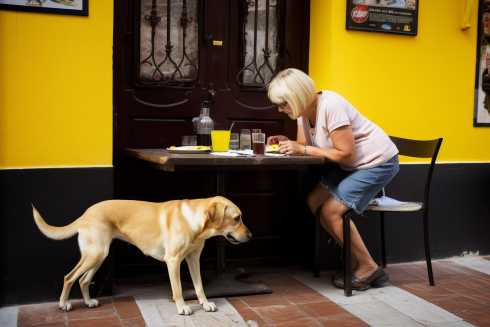A GIFT traditionally offered by bars in Granada Province, the ‘tapa’ has a long history. Exactly how it was invented depends on the source you believe.
One legend says that, in the 13th century Spain, King Alfonso X – ‘The Wise One’ – passed a decree forcing taverns to serve a small portion of food with wine to reduce drunkenness. Whether it worked is anyone’s guess, but Spain clearly has less of a public ‘borracho’ problem than some other countries, including the UK.
In pre-19th-century Andalucia, the ‘posadas’, ‘alberques’ and ‘bodegas’ (roadside bars and hostals) were said to offer small samples of their dinner options, in the form of ‘tapas’. This was, apparently, because few proprietors could read or write, and could not create a menu board.



A salty lid to prevent flies
The most credible explanation is that the original ‘tapas’ were ‘tops’ of bread or meat. Drinkers placed these over their wine, to prevent buzzing flies from falling into the glass when they weren’t sipping.
Sometimes, the drink would be covered with local meat products, such as Serrano ham or chorizo. As these are salty, they made clients thirstier, which – in turn – increased drink sales. The meaty items expanded into other types of ‘tapas’, such as ‘carne en salsa’ or potato dishes.
Eventually, the ‘tapas’ became as important as the alcohol. Today, the choice is endless, and the savvy drinker knows which bars, in their town, will serve the best ‘tapas’.
In 2022, the mayor of Granada threatened to end free ‘tapas’ but, to date, this hasn’t happened. It is one of the major attractions of the province.
Traditional and seasonal tapas
‘Tapas’ can be hot or cold. What’s served can depend on seasonal factors. For example, when baby broad beans are in season (soon), these are used in ‘habas con jamón’. In summer, you might receive ‘pipirrana’ (a type of salad combining cold tomatoes, peppers, etc.), as well as ‘potaje de hinojos’ when fennel is in season, and meatballs in almond sauce when those are abundant.
Cold ‘tapas’, served all year round, frequently includes olives, nuts, cheese, chorizo, ham, Russian salad, tortilla, potato crisps, or – if you’re unlucky – crab sticks.
Hot dishes commonly include: ‘patatas a lo pobre’, potato chips (‘a lo rico’), ‘migas’, meatballs, pork strips in creamy sauce, ‘carne en salsa’, ‘lorganiza’, cod, squid, prawns, paella rice, aubergine in honey, croquettes, sardines or ‘boquerones’ and, sometimes, ‘puchero’ or other stews. ‘Callos’ is a stew with chickpeas that you then discover contains ‘some form of unidentifiable offal’, that might be pig’s feet.
In old-school bars, visitors might still encounter cuts of meat that aren’t so noble. This has scared a few Brits, who aren’t accustomed to ‘strange’ animal parts.
One reader, Frances Shaw, reported being served “garden snails in Almegijar – I couldn’t eat them”. Expat, Richard Kayshan, said: “At a hotel in La Alpujarra, I was literally served a pig’s trotter on a plate.” Another unfortunate Brit, Jane Ryder, was served “nostrils”, but in a different region of Spain.
“I once had Haribo sweeties on a bed of beef flavoured crisps in Pinos del Valle,” said Heather Sutherland. Although this is hardly haute cuisine, at least it’s not offal.
Contemporary tapas and chef’s specials
Some bars have adapted to serve tapas with a decidedly modern twist – whether it is a mini-tortilla or hamburger, a contemporary salad, or something of their own invention.
Many times, you will sample the chef’s special, especially if they have over-provisioned for the lunch guests and have leftovers in the kitchen.
Turning up at 3pm Sunday is a good way to get whatever delicious, hot food remains unserved in the pan.



International restaurants might offer samples of their main menu. For example, a pizzeria might serve pizza slices, if you are lucky.
One venue in Alhendin, Granada – called Bar Santi – has served entirely fish tapas since the 1960s. This is great but can be a bit repetitive if you over-imbibe and reach tapas number eight….
Tapas events and trails
Many municipalities, such as Lanjaron in La Alpujarra, have an annual ‘Ruta de la Tapa’ event. Visitors are invited to sample the ‘tapa’ in qualifying bars, and rate it on a marking sheet. The bar with the best tapa usually wins a prize, as do some of the participants. With maybe 20 bars participating, this is an event where you need a designated driver – if you don’t want to consume endless rounds of alcohol-free drinks.
In Granada central, you can find tapas tours with multilingual guides. This could be a good option for tourists who definitely want to eliminate any chance of receiving trotters or crab sticks.

Tapas hints and tips
- Avoid obvious tourist traps. Instead, seek old man bars (sometimes called the ‘pensionista’) and those popular with Spanish workers. Any venue with a busy terrace full of locals is likely to serve decent tapas.
- Don’t turn up too early, before the kitchen is open, or you’re likely to receive crisps with olives rather than hot food. Around 2pm and 9pm are good timeslots.
- Don’t be shy to tell the barman if you have food allergies (‘sin gluten’) or any strong dislikes. Once the prawns have arrived, it’s a bad moment to say you dislike seafood.
Remember that tapa is a gift – so try not to cause offense by pulling awful faces or criticising the standard of cuisine. - Don’t openly feed tapas to your dog – it’s more polite to put it in a serviette and take it home for Fido to enjoy later.
- Some bars don’t serve tapas with ‘agua con gas’ or ‘batidos’. Check what qualifies before ordering a round of drinks.
READ MORE
- WINE COUNTRY: The Alpujarra and Contraviesa of Spain’s Granada have produced wine for 2,000 years and it’s still a corking success
- CARVING A NAME FOR ITSELF: How Trevelez, one of Spain’s highest villages, has built a tourist trade around its famous cured ham
Click here to read more News from The Olive Press.








